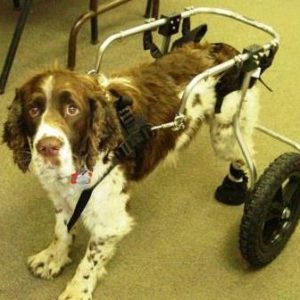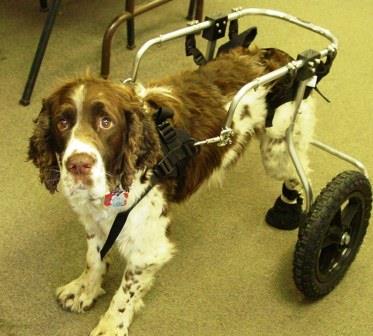Symptoms
After an annual Thanksgiving canoe camping trip on the Current River in the Ozarks, Kaylee began limping. I had forgotten to bring her fleece booties and after a few days of camping on the sharp rocks, her paws often developed small cracks and became sore. But usually after going home, her paws healed in a day or two and she’d act her normal self—always ready to go for a walk or play ball.
Not this time. She still limped after a week, so I took her to the vet. He diagnosed arthritis and prescribed Rimadyl for the 8-year-old springer spaniel. Kaylee developed severe diarrhea so I stopped using it after a few days. Aspirin helped her somewhat. But a month later, she’d stay in her bed and limped a few feet into our yard for potty breaks several times a day. The vet suggested trying Rimadyl again. Her system now tolerated the drug, but I couldn’t see any change in Kaylee.
Another month went by and Kaylee stopped using her back right leg, the same one she had broken in a bad fall many years before. Since the vet didn’t seem to have any solutions, I accepted her condition as the new normal—something I shouldn’t have done. Not until a friend said that her condition seemed a lot worse than arthritis, did I go back to the vet at the end of February.
Diagnosis
This time the vet took an x-ray. He showed me the film and pointed to a white mass on her bone. It looked like bone cancer and he recommended amputation. When I returned home and told my husband, he said to get a second opinion. My vet recommended an oncologist. The specialist took one look at Kaylee limping and said to amputate the leg immediately since she was in so much pain. Until he said this, I had thought it hurt her only to use the leg, not that she was in constant pain.
The next day we had the vet amputate Kaylee’s leg. A biopsy confirmed the tumor as osteosarcoma, a fast-growing bone cancer.
Care
Kaylee recovered quickly from the amputation and it brought new energy to her. She could run and go for walks, although much shorter since she tired easily on three legs.
In the early 2000’s, the life expectancy of dogs with osteosarcoma was 6 – 8 months with amputation, only a few months without. Chemotherapy could extend their life only by a few more months. I researched my options and found two places for chemotherapy, one was with the oncologist—there the cost was four grand, the other was a veterinary school for half that price, but a two hour drive each way.
My husband and I chose not to have chemotherapy treatments for Kaylee. It didn’t seem worth the trouble of subjecting her to long chemotherapy treatments for only extending her life a few more months. Plus there was the cost.

Kaylee lived two years from the time she started limping, although it was not a good two years. But her story and our struggles inspired me to become a writer and create a memoir about her. Here is a summary of her struggles:
- About 7 months after her amputation (October), Kaylee started wobbling and falling, so I purchased a wheelchair. The wheelchair allowed her much more endurance on walks and helped with her balance. But due to the size and extended wheelbase, she could only use it outside since she kept catching the wheels on door frames and furniture.
- A week after Thanksgiving, she developed paralysis in her hind end and most of her back. Since it had been a year since she started limping, I accepted my vet’s conclusion that it was time to euthanize her. She had lived longer than most of the dogs I had read about. My husband was out of town, so I had to wait a few days for his return.
- My husband suggested a rehab clinic less than ten miles away, just to get a second opinion. We took Kaylee to Tops Veterinary Rehabilitation in Grayslake, IL. The veterinarian said she could help Kaylee, probably not walk again, but regain some mobility and ease her discomfort. We immediately signed on for treatments that included massage, acupuncture and the underwater treadmill. Although each individual treatment was reasonable, the number of visits and the length of time made this program quite costly—to the point where I took on a second job to pay for Kaylee’s treatments.
- Kaylee only improved slightly, possibly since she had not seen the rehab vet until more than two days after her paralysis, or possibly due to her cancer. Kaylee improved so she could lie on her chest, which allowed her to eat normally and play catch. But if she fell over on her side, she was stuck in that positon until someone repositioned her.
- Her muscles grew sore if she stayed in one position too long, so I had to roll her over about every four hours. I awoke once or twice each night to her whimpering. I tried to have her near me at all times. Often this wasn’t possible and I would return to find her on her side, her face slathered in drool and panting as she tried to move.
- She needed assistance with eliminating. She didn’t leak urine, so she didn’t need diapers (unless she had diarrhea. She could lock her front legs in place while standing, so we could express her bladder and bowels. I always had trouble with getting her to poop, but my husband was good at it.
- Kaylee needed daily range-of-motion exercises, which I admit, I didn’t enjoy doing and I performed them as quickly as possible.
- To reduce costs at the rehab vet, I learned massage and used our hot tub instead of the underwater treadmill. Our hot tub was outside, so I did this through the winter until I realized it wasn’t helping her.
- Since Kaylee couldn’t walk, I had to carry a 43 lb. dog everywhere. She did have limited mobility in her front legs and could walk slowly in her wheelchair or with a sling and harness.
- The following October, eleven months after she became paralyzed, Kaylee fainted while I had her outside to pee. She regained consciousness within a few minutes, but panted from the effects for a long time. But by the next day she was fine when I took her to the vet. He said maybe she had a mini-stroke, but couldn’t offer any assistance and said it might be an effect from her cancer. I had noticed that hours before her fainting episode, she had grown restless and refused to eat, which was very unusual for her.
- Kaylee fainted two more times, about three weeks apart. The second one was milder and she recovered faster. The third one had a very long lead time of over twelve hours. She whimpered and panted keeping me awake most of the night. I debated most of the night about taking her to the emergency vet, but I was afraid my only option was euthanasia. I also knew my husband would talk me out of it. In the morning, she fainted and did not recover. She died peacefully in our kitchen with my husband and me petting her.
Lessons Learned
Kaylee had a very long illness that affected my finances, my job, and even my relationship with my husband. I don’t know if I could do it all again. But knowing that I did it once would give me strength to do it again if I had to. Several key lessons learned:
- If your vet doesn’t give you a reasonable solution—get a second opinion. I should have done this soon after Kaylee showed no signs of improvement after taking Rimadyl.
- Don’t be afraid to go to an emergency vet if your dog is in distress. I hesitated not just because of the cost, but also since the only option seemed to be euthanasia.
- Research all your options, which I had done at that time. But new treatments may be available and possibly new studies at veterinary schools. Don’t assume your vet has kept up to date on all the research.
- Reach out on social media for tips and information. One post on an osteosarcoma website stated that her dog had lived two years since she began limping. That one post gave me hope that lasted throughout Kaylee’s illness.
- Have a few items such as diapers (for those diarrhea attacks) at home. We used swim diapers for toddlers the first time. I also recommend a harness and sling to help your dog balance.
- Evaluate your dog’s quality of life. Kaylee always seemed satisfied with our attention and food. She only seemed to suffer when we had to leave her more than about four hours and her muscles became sore from staying in the same position. She also suffered prior to these fainting attacks, but then she bounced back to her usual self by the next day.
- Budget—this is very hard when it comes to your dog. I had not known that rehabilitation requires many visits and treatments over possibly a long range of time. I calculated Kaylee’s costs at about $7K from the time she started limping until her death. These extra costs caused me to find a second job, which fortunately, I still love, but it added to my stress. I’m not sure if I would do anything different, but just beware of the potential costs.
- Know what you are willing to do and not do. Kaylee’s paralysis became a ball and chain to me with her constant needs. Fortunately, I could bring Kaylee to work and had an understanding boss. But the long-term stress affected my relationship with my husband and contributed to us eventually seeing a marriage counselor.
Have you or someone you know had a dog with osteosarcoma? Please write to me and tell me their story at Sandy@caninecancerconcerns.com or leave a message on my contact form.


Hello, jist wanted to tell you, I enjoyed this post.
It was helpful. Keep on posting!! Cheers
I’m glad that you enjoyed it. Thanks.